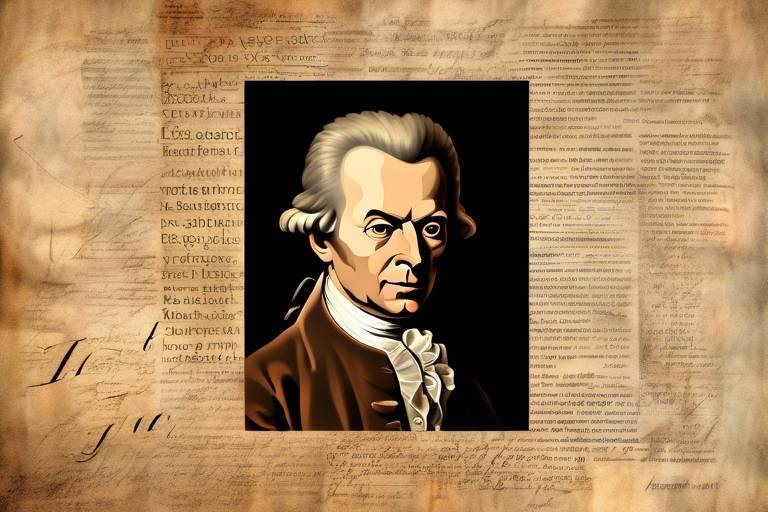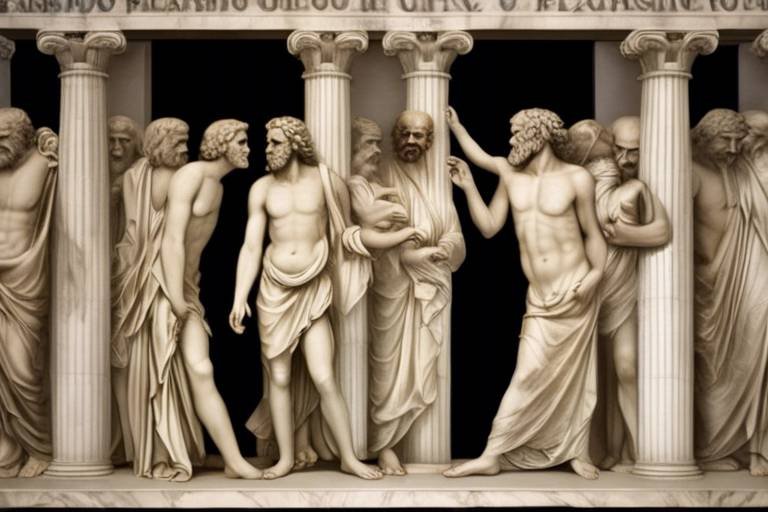Immanuel Kant's Metaphysical Thoughts - A Deeper Perspective
This article explores the intricate metaphysical concepts proposed by Immanuel Kant, delving into his ideas on knowledge, reality, and the limits of human understanding. Kant, a towering figure in Western philosophy, challenged the very foundations of how we perceive the world around us. His work compels us to consider not just what we know, but how we come to know it, and whether we can ever truly grasp the essence of reality itself. As we journey through Kant's metaphysical landscape, we will uncover the distinctions he draws between phenomena and noumena, and how these concepts shape our understanding of existence.
Kant's metaphysics is built upon the distinction between phenomena and noumena, shaping our understanding of reality and knowledge. To put it simply, phenomena are the things we can perceive and experience, while noumena represent the things that exist independently of our perception. This foundational idea is crucial for grasping Kant's philosophical framework. He argues that our knowledge is limited to the realm of phenomena; in other words, we can only understand the world as it appears to us, not as it is in itself. This distinction invites us to ponder: if we cannot access noumena, can we ever claim to know the true nature of reality?
Transcendental idealism is a key aspect of Kant's philosophy. He posits that our experiences are not merely reflections of the external world but are significantly shaped by the inherent structures of the mind. Imagine your mind as a lens through which you view the world; this lens filters and organizes sensory information, creating a coherent picture of reality. Kant contends that these mental frameworks are not arbitrary; they are essential to how we interpret our experiences. This leads us to question: how much of what we perceive is influenced by our own cognitive structures rather than the external objects themselves?
Kant introduces categories as essential concepts that organize our experiences. These categories, such as causality and unity, serve as the building blocks of human understanding. They are like the rules of a game that dictate how we interpret the world. Without these categories, our experiences would be chaotic and incomprehensible. Kant's assertion is that these innate structures help us make sense of the world around us, allowing us to form judgments and engage in rational thought. So, next time you ponder a cause-and-effect relationship, remember that it’s not just a coincidence; it’s a fundamental category of your understanding at work.
Understanding the specific categories Kant identifies is crucial for grasping his metaphysical approach. Categories such as causality, which allows us to understand that events are linked in a chain of cause and effect, and unity, which helps us perceive objects as singular entities, play a significant role in shaping human cognition. These categories are not learned; they are inherent to our cognitive faculties. Thus, they fundamentally influence how we perceive and interact with the world. They are the lens through which we view our existence, making them indispensable for any meaningful inquiry into reality.
This section examines how Kant's categories influence our experiences, emphasizing their role in interpreting sensory data and forming coherent perceptions of reality. For instance, when you see a tree, your mind automatically categorizes it as a 'tree' based on its characteristics, such as its trunk, branches, and leaves. This categorization process enables you to understand and interact with the world effectively. Without these cognitive categories, our sensory experiences would be nothing more than a disorganized jumble of impressions, lacking any meaning or coherence.
Kant asserts that there are inherent limits to human knowledge. He argues that while we can know the world of phenomena, we are forever barred from fully comprehending noumena—the things as they are in themselves. This limitation raises profound questions about the nature of existence and our place in the universe. If our understanding is fundamentally constrained, what does that mean for our quest for knowledge? Are we destined to only scratch the surface of reality, forever searching for answers that remain just out of reach?
Kant's concept of the thing-in-itself refers to objects as they exist independently of our perception. This notion implies that there is a reality beyond our sensory experiences that we cannot access or comprehend. The implications of this idea for metaphysics are staggering. If the thing-in-itself exists beyond our understanding, then what can we truly claim to know about the world? This philosophical conundrum invites us to explore the very nature of existence and reality. It challenges us to consider whether our perceptions are merely shadows of a deeper truth that remains hidden from us.
Exploring the thing-in-itself raises questions about the nature of existence and reality. If we can never fully grasp the essence of things, what does that mean for metaphysical inquiry? This subheading highlights its significance in metaphysical discussions and philosophical debates. It compels us to confront the limitations of our understanding and the potential futility of our search for absolute truth. In a way, Kant's philosophy serves as a reminder that the quest for knowledge is as much about recognizing our limitations as it is about expanding our understanding.
Kant's ideas bridge the gap between empiricism and rationalism. He acknowledges the importance of sensory experience in acquiring knowledge while also asserting that reason plays a crucial role in organizing and interpreting that experience. This section analyzes how his metaphysical thoughts reconcile these two philosophical traditions, reshaping the landscape of modern philosophy. By synthesizing these approaches, Kant opens new avenues for understanding the complexities of knowledge and reality, inviting us to consider how both experience and reason contribute to our comprehension of the world.
- What is Kant's distinction between phenomena and noumena? Kant differentiates between phenomena (the world as we perceive it) and noumena (the world as it exists independently of our perception).
- What is transcendental idealism? It is the view that our experiences are shaped by the mind's structures, influencing our perception of reality.
- What are Kant's categories? Categories are innate concepts that organize our experiences, helping us make sense of the world.
- What does the thing-in-itself refer to? It refers to objects as they exist independently of our perception, highlighting the limits of human knowledge.
- How does Kant reconcile empiricism and rationalism? Kant argues that both sensory experience and reason are essential for acquiring knowledge, bridging the gap between these two philosophies.

The Foundation of Kant's Metaphysics
Kant's metaphysics serves as a fascinating cornerstone in the realm of philosophy, intricately weaving together the threads of knowledge, perception, and reality. At the heart of his philosophical framework lies a crucial distinction between phenomena and noumena. Phenomena represent the world as we experience it, shaped by our senses and cognitive faculties, while noumena refer to things as they exist independently of our perception. This distinction is not merely academic; it fundamentally alters how we understand our existence and our place within the universe.
To grasp Kant's metaphysical insights, one must first appreciate the implications of these two realms. Imagine the phenomena as a vibrant painting, rich with colors and details, while the noumena are the canvas and the paint itself—elements that exist but are often obscured from our direct observation. This analogy highlights how our experiences are filtered through the lens of our cognitive structures, which Kant meticulously outlines in his works.
Central to this exploration is the idea that our understanding of reality is not a passive reflection of the world around us. Instead, it is an active construction, shaped by the innate categories of our mind. These categories are like the tools of a craftsman, allowing us to mold raw experiences into coherent perceptions. Kant identifies several key categories, including causality, unity, and plurality, which serve as the fundamental building blocks of human cognition.
Understanding these categories is vital for anyone delving into Kant's metaphysical thoughts. They not only help us navigate our sensory experiences but also define the limits of what we can comprehend. For instance, the category of causality allows us to make sense of events in a linear fashion—understanding that one event leads to another. Without such categories, our experiences would be a chaotic jumble, devoid of meaning and coherence.
The interplay between phenomena and noumena raises profound questions about the nature of knowledge itself. If our understanding is inherently shaped by our cognitive structures, how can we claim to know anything about the world as it truly is? This inquiry leads us to the realization that while we can construct a rich tapestry of understanding based on our experiences, there will always be aspects of reality that remain elusive, forever beyond our grasp.
In summary, the foundation of Kant's metaphysics is built upon the critical distinction between phenomena and noumena, coupled with the essential categories that shape our understanding. This framework not only provides a lens through which we can examine our experiences but also invites us to reflect on the limitations of our knowledge. As we continue to explore Kant's ideas, we uncover a rich landscape of philosophical inquiry that challenges our preconceived notions and inspires deeper contemplation.

Transcendental Idealism
Transcendental idealism is a pivotal concept in Immanuel Kant's philosophy, acting as the backbone of his metaphysical framework. At its core, it posits that our experiences of the world are not merely passive reflections of external reality, but rather shaped by the innate structures of our minds. Imagine trying to view a beautiful painting through a foggy glass; the glass alters the way you perceive the colors, details, and overall image. Similarly, Kant argues that our minds actively participate in constructing our understanding of reality, filtering and shaping the sensory information we receive.
To grasp the essence of transcendental idealism, one must first understand Kant's assertion that there are two realms of existence: the phenomenal world, which is the world as we experience it, and the noumenal world, which is the world as it exists independently of our perception. The phenomenal world is accessible to us through our senses and is structured by the categories of understanding that Kant identifies. On the other hand, the noumenal world remains elusive and unknowable, a realm that lies beyond the grasp of human cognition. This distinction is crucial, as it highlights the limitations of human knowledge and the role our minds play in interpreting the reality around us.
Kant's transcendental idealism challenges us to reconsider the nature of knowledge itself. Instead of viewing knowledge as a simple correspondence between our thoughts and the external world, Kant invites us to see it as a complex interplay between our mental faculties and the phenomena we encounter. This perspective leads to profound implications for various fields, including science, ethics, and metaphysics. For instance, in science, it suggests that our scientific theories are not mere reflections of reality but constructs that help us navigate and understand the phenomenal world.
In essence, transcendental idealism serves as a bridge between subjective experience and objective reality. It encourages us to acknowledge that while we can never fully access the noumenal world, our understanding of the phenomenal world is rich and meaningful, shaped by the cognitive structures that define our perception. This philosophical stance not only reshapes our approach to metaphysics but also opens up new avenues for inquiry into the nature of existence and our place within it.
As we delve deeper into Kant's thought, it becomes clear that transcendental idealism is not just a theoretical framework but a call to explore the intricate relationship between our minds and the world. It prompts us to ask ourselves questions such as: How do our perceptions shape our reality? What are the limits of our understanding? And ultimately, what does it mean to know something? These inquiries are at the heart of Kant's philosophy and continue to resonate in contemporary discussions about knowledge and existence.

The Role of the Categories
In the realm of Immanuel Kant's philosophy, the concept of categories serves as a pivotal foundation for understanding how we perceive and interpret the world around us. Kant proposed that our minds are not merely passive recipients of sensory data; rather, they actively shape our experiences through these innate categories. Think of categories as mental frameworks or lenses that filter and organize our perceptions, enabling us to make sense of the chaos of sensory input. Without these categories, our experiences would be jumbled and incoherent, much like trying to read a book with pages torn out and scattered everywhere.
Kant identified several key categories that play a crucial role in this process, including:
- Causality: This category allows us to understand cause and effect, enabling us to make predictions about future events based on past experiences.
- Unity: This helps us recognize objects as singular entities, allowing us to differentiate between various objects in our environment.
- Time and Space: These categories provide the necessary framework for organizing experiences in a temporal and spatial context.
Each of these categories is not merely an abstract concept; they are fundamental to the way we interact with the world. For instance, consider how we navigate our daily lives. When you pour a cup of coffee, your understanding of causality tells you that the action of lifting the pot will lead to the coffee filling the cup. Without this category, the act would seem random and disconnected from your intention. In this way, categories are not just philosophical ideas; they are the mental tools we use to construct our reality.
Moreover, Kant's categories highlight the active role of the mind in shaping reality. They emphasize that our understanding of the world is not a direct reflection of the external world but rather a product of the interplay between our sensory experiences and these innate structures. This leads to the profound realization that while we can know the world through our perceptions, we can never fully grasp the essence of things as they exist independently of us. This brings us to the crux of Kant's metaphysical inquiry, where the boundaries of human knowledge are continually tested against the backdrop of these categories.
In conclusion, the role of categories in Kant's philosophy cannot be overstated. They are essential for organizing our experiences and providing coherence to our understanding of reality. By recognizing that our perceptions are shaped by these mental frameworks, we gain insight into the limitations of our knowledge and the complexity of the world we inhabit. Kant's exploration of categories invites us to reflect on the nature of our understanding and challenges us to consider how much of our reality is constructed rather than simply observed.
- What are Kant's categories?
Kant's categories are innate concepts that help us organize and interpret our experiences, including causality, unity, time, and space. - How do categories influence our perception of reality?
Categories shape our understanding by filtering sensory data, allowing us to make sense of our surroundings and form coherent experiences. - Can we know the 'thing-in-itself' according to Kant?
No, Kant argues that we can never fully know the 'thing-in-itself'; we only know things as they appear to us through our categories.

Categories of Understanding
Understanding Kant's categories is like discovering the secret keys to a locked treasure chest of knowledge. These categories are not just random concepts; they are the fundamental building blocks through which we interpret and make sense of our experiences. Kant identified several categories that play a crucial role in shaping human cognition, allowing us to navigate the complex world around us. Imagine trying to put together a jigsaw puzzle without the edge pieces; you’d be lost! The categories provide that necessary framework, ensuring that our perceptions are coherent and structured.
One of the most significant categories is causality. This principle allows us to understand the relationship between events and actions. For instance, when we see a ball roll after being kicked, it’s our understanding of causality that helps us make the connection between the kick and the ball's movement. Without this category, we would be left in a chaotic world where events occur without any apparent reason or connection.
Another essential category is unity. This concept helps us recognize that our diverse experiences and perceptions are part of a singular reality. Think of it like a symphony orchestra; each instrument plays a distinct note, but together, they create a harmonious piece of music. Similarly, unity allows us to integrate various sensory inputs into a cohesive understanding of our environment.
In addition to causality and unity, Kant proposed other categories such as plurality, which deals with the concept of many versus one, and necessity, which addresses the idea of what must be versus what merely can be. Each of these categories serves a unique purpose, yet they work in harmony to facilitate our understanding of reality.
To illustrate the importance of these categories further, let’s take a look at the following table that summarizes Kant's categories and their implications:
| Category | Description | Implication |
|---|---|---|
| Causality | Understanding cause and effect relationships | Enables us to predict outcomes based on actions |
| Unity | Recognizing the interconnectedness of experiences | Facilitates a coherent perception of reality |
| Plurality | Understanding the concept of many versus one | Helps in categorizing and organizing knowledge |
| Necessity | Distinguishing what must be from what can be | Guides our understanding of laws and principles |
In essence, Kant's categories of understanding are indispensable for our cognitive processes. They not only help us interpret our sensory experiences but also lay the groundwork for deeper philosophical inquiries into the nature of reality itself. By grasping these categories, we unlock a greater understanding of how we perceive the world, making Kant's metaphysical framework an essential study for anyone interested in the intricacies of human thought.

Categories and Experience
Kant’s exploration of categories is not just a dry philosophical exercise; it’s a vibrant tapestry that weaves together our experiences and understanding of the world. Imagine walking through a bustling market. The sights, sounds, and smells bombard your senses, but how do you make sense of it all? This is where Kant’s categories come into play. They are like the mental filters that help us organize and interpret the chaotic data our senses provide.
According to Kant, our mind doesn’t passively receive information; it actively shapes our experiences through these innate categories. For instance, when you see a fruit vendor selling apples, your understanding of the situation is filtered through various categories such as causality and unity. You recognize that the vendor is selling apples (unity), and you understand that the act of purchasing an apple would lead to you having an apple (causality). Without these categories, the experience would be a jumbled mess of sensory input, lacking coherence and meaning.
To further illustrate this point, let’s consider a few key categories identified by Kant:
- Unity: This category helps us perceive objects as singular entities rather than just a collection of sensory experiences.
- Cause and Effect: This allows us to understand that events are connected, creating a narrative out of our experiences.
- Time and Space: These categories help us place events in a temporal and spatial context, enriching our understanding of sequences and locations.
These categories are not just theoretical constructs; they are essential tools that shape our daily lives. When you hear a song, you don’t just hear a series of notes; you perceive a melody with structure and rhythm, thanks to the categories of harmony and time. In this way, Kant argues that our experiences are inherently structured by these categories, allowing us to navigate the world with a sense of clarity and coherence.
Furthermore, Kant emphasizes that these categories are universal and necessary for all human experience. They are like the rules of a game that everyone must follow to play effectively. Without them, our experiences would lack the framework needed for understanding and communication. This is why Kant’s metaphysical thoughts are so revolutionary; they provide a foundation for how we comprehend not just individual experiences, but the very nature of reality itself.
In summary, Kant’s categories are not mere philosophical abstractions; they are the lenses through which we view and interpret our experiences. They help us transform raw sensory data into meaningful understanding, bridging the gap between perception and reality. So, the next time you find yourself reflecting on an experience, remember that it’s not just a passive observation; it’s a complex interplay of categories that shapes your reality.
- What are Kant's categories? Kant's categories are innate concepts that structure our experiences and understanding of the world, such as unity, causality, and time.
- How do categories influence our perception? They help us organize sensory information, allowing us to interpret and make sense of our experiences coherently.
- Why are Kant's categories important? They provide a framework for understanding reality, bridging subjective experiences with objective knowledge.

Limits of Human Knowledge
Immanuel Kant's philosophy brings to light a fundamental question: What can we truly know? He argues that there are inherent limits to human knowledge, which is a bold claim that challenges our instinctive belief in our ability to understand everything around us. Kant posits that our knowledge is confined to the world of phenomena, the realm we experience through our senses. In contrast, the noumenal world—the reality that exists beyond our perception—remains largely inaccessible to us. This distinction is crucial as it sets the stage for understanding the boundaries of human cognition and inquiry.
Kant suggests that while we can gather a wealth of information from our experiences, this knowledge is always filtered through our senses and interpreted by our mental faculties. The implications of this are profound: we cannot claim to know things as they are in themselves. Instead, we only know them as they appear to us. This leads to a fascinating paradox: the more we learn, the more we realize how much we don't know. It’s like trying to see the ocean from the shore; you can catch glimpses of its vastness, but you’ll never truly grasp its depths without diving in.
To illustrate this idea further, consider the following table that summarizes Kant's view on the limits of human knowledge:
| Aspect | Phenomena | Noumena |
|---|---|---|
| Definition | The world as we perceive it | The world as it exists independently |
| Accessibility | Accessible through senses and experience | Inaccessible to human understanding |
| Knowledge Type | Empirical knowledge | Speculative knowledge |
Kant also emphasizes that our cognitive faculties impose certain structures on our experiences. For instance, concepts like time and space are not merely external realities; they are the lenses through which we interpret the world. This leads us to a critical understanding: our knowledge is not a direct reflection of reality but rather a construction shaped by our mental frameworks. In this light, we must accept that there are limits to what we can know, and this acceptance can be liberating. It allows us to embrace the mystery of existence rather than feeling constrained by the need to have all the answers.
In conclusion, Kant's exploration of the limits of human knowledge invites us to ponder our place in the universe. While we may strive for understanding, we must acknowledge that some aspects of reality will always elude us. This realization can be both humbling and empowering, as it encourages a continuous quest for knowledge while recognizing the beauty of the unknown. So, the next time you find yourself grappling with a profound question, remember Kant's wisdom: the pursuit of knowledge is a journey, not a destination.
- What is the difference between phenomena and noumena?
Phenomena refer to the world as we perceive it, while noumena represent the reality that exists independently of our perception. - Why are there limits to human knowledge according to Kant?
Kant argues that our understanding is shaped by our sensory experiences and cognitive structures, which confine us to knowing only the world of phenomena. - How does Kant's philosophy influence modern thought?
Kant's ideas bridge gaps between different philosophical traditions, prompting debates on knowledge, existence, and the nature of reality.

The Thing-in-Itself
Kant's concept of the thing-in-itself (or noumenon) is a fascinating yet complex idea that challenges our understanding of reality. To put it simply, the thing-in-itself refers to objects as they exist independently of our perception. Imagine looking at a beautiful painting; the colors, the strokes, the emotions they evoke are all filtered through your senses and interpretations. But what if I told you that the essence of that painting exists outside of your perception? That’s what Kant means by the thing-in-itself. It’s the reality that exists beyond our sensory experiences and cognitive frameworks—a reality that remains elusive and ultimately unknowable.
In Kantian philosophy, this concept raises profound questions about the nature of existence. If we can only know things as they appear to us—through our senses and mental categories—then how can we ever claim to understand the true essence of reality? This leads us to consider the implications of the thing-in-itself for metaphysical inquiry. It suggests that our grasp of reality is inherently limited, shaped by the structures of our mind and the confines of our perception. Just like trying to grasp smoke with your hands, the more you reach for the true nature of reality, the more it slips away.
To delve deeper, let’s break down some key implications of the thing-in-itself:
- Reality Beyond Perception: The thing-in-itself posits that there is a reality that exists beyond what we can observe. This challenges the empirical view that experience is the sole source of knowledge.
- Limits of Human Understanding: Kant argues that our cognitive faculties are limited. We can only interact with phenomena—the world as we perceive it—while the noumena remain beyond our reach.
- Philosophical Inquiry: This concept invites deeper philosophical discussions about existence, knowledge, and the relationship between the observer and the observed. It opens up a realm of inquiry that questions the very foundations of metaphysics.
Moreover, the thing-in-itself plays a crucial role in distinguishing Kant's philosophy from both empiricism and rationalism. While empiricists argue that knowledge comes solely from sensory experience, and rationalists believe that reason alone can lead to knowledge, Kant's view is a bridge between the two. He acknowledges that our experiences are shaped by both our sensory input and the innate categories of understanding we possess. Thus, the thing-in-itself serves as a reminder that there is more to reality than what meets the eye.
In conclusion, the thing-in-itself is not just a philosophical concept; it’s a gateway to understanding the limitations of human cognition and the nature of reality itself. It challenges us to think critically about our perceptions and the essence of existence, reminding us that what we perceive is merely a shadow of the true reality that lies beyond our grasp.
What is the thing-in-itself?
The thing-in-itself refers to objects as they exist independently of our perception, highlighting the distinction between what we perceive and the true essence of reality.
Why is the thing-in-itself important in Kant's philosophy?
It emphasizes the limits of human understanding and challenges the notion that we can fully comprehend reality through our senses alone.
How does the thing-in-itself relate to empiricism and rationalism?
Kant's concept bridges the gap between empiricism, which focuses on sensory experience, and rationalism, which emphasizes reason, by asserting that both play a role in shaping our understanding of phenomena.

thing-in-itself
This article explores the intricate metaphysical concepts proposed by Immanuel Kant, delving into his ideas on knowledge, reality, and the limits of human understanding.
Kant's metaphysics is built upon the distinction between phenomena and noumena, shaping our understanding of reality and knowledge. This section examines the core principles that underpin his philosophical framework.
Transcendental idealism is a key aspect of Kant's philosophy. This section discusses how Kant argues that our experiences are shaped by the mind's structures, influencing our perception of reality.
Kant introduces categories as essential concepts that organize our experiences. This subheading explores how these innate structures help us make sense of the world around us.
Understanding the specific categories Kant identifies, such as causality and unity, is crucial for grasping his metaphysical approach. This section highlights their significance in shaping human cognition.
This section examines how Kant's categories influence our experiences, emphasizing their role in interpreting sensory data and forming coherent perceptions of reality.
Kant asserts that there are inherent limits to human knowledge. This part delves into his arguments regarding the boundaries of what we can know and understand.
Kant's concept of the refers to objects as they exist independently of our perception. This notion is pivotal in understanding the limitations of human cognition. While we can perceive phenomena—those things as they appear to us—Kant argues that we can never truly grasp the thing-in-itself, which exists beyond our sensory experience.
Exploring the raises profound questions about the nature of existence and reality. It challenges us to consider that our understanding of the universe is inherently limited. Kant posits that while we can theorize about the , our knowledge is always mediated through the lens of our perceptions and experiences. This leads to a fundamental inquiry: if we cannot know the , how can we claim to know anything at all?
Kant's ideas bridge the gap between empiricism and rationalism, reshaping the landscape of modern philosophy. By asserting that our knowledge arises from both sensory experience and innate concepts, he reconciles these two philosophical traditions. This synthesis not only enhances our understanding of the but also emphasizes the role of human cognition in shaping reality.
- What is the thing-in-itself?
The refers to objects as they exist independently of our perception, which Kant argues we can never fully know. - How does Kant's concept of the thing-in-itself affect our understanding of reality?
Kant's concept suggests that our understanding of reality is limited to phenomena, and we can only theorize about the . - What is the significance of Kant's metaphysics?
Kant's metaphysics challenges the boundaries of human knowledge and emphasizes the role of perception in shaping our understanding of the world.

refers to objects as they exist independently of our perception. This section discusses its implications for metaphysics and the nature of reality.
This article explores the intricate metaphysical concepts proposed by Immanuel Kant, delving into his ideas on knowledge, reality, and the limits of human understanding.
Kant's metaphysics is built upon the distinction between phenomena and noumena, shaping our understanding of reality and knowledge. This section examines the core principles that underpin his philosophical framework.
Transcendental idealism is a key aspect of Kant's philosophy. This section discusses how Kant argues that our experiences are shaped by the mind's structures, influencing our perception of reality.
Kant introduces categories as essential concepts that organize our experiences. This subheading explores how these innate structures help us make sense of the world around us.
Understanding the specific categories Kant identifies, such as causality and unity, is crucial for grasping his metaphysical approach. This section highlights their significance in shaping human cognition.
This section examines how Kant's categories influence our experiences, emphasizing their role in interpreting sensory data and forming coherent perceptions of reality.
Kant asserts that there are inherent limits to human knowledge. This part delves into his arguments regarding the boundaries of what we can know and understand.
Kant's concept of the thing-in-itself refers to objects as they exist independently of our perception. This section discusses its implications for metaphysics and the nature of reality.
Exploring the thing-in-itself raises profound questions about the nature of existence and reality. Kant suggests that while we can perceive phenomena—things as they appear to us—there exists a realm of reality that is fundamentally inaccessible to human cognition. In other words, the thing-in-itself represents a reality that is beyond our sensory experiences and conceptual frameworks. This notion challenges the very foundations of metaphysical inquiry, as it implies that our understanding of the universe is inherently limited. The implications are vast:
- It invites skepticism about our ability to know the true nature of reality.
- It emphasizes the distinction between subjective experience and objective existence.
- It raises questions about the reliability of human perception as a means of understanding the world.
By acknowledging the existence of the thing-in-itself, Kant compels us to reconsider our assumptions about knowledge, urging us to accept that some aspects of reality may remain forever beyond our grasp.
Kant's ideas bridge the gap between empiricism and rationalism. This section analyzes how his metaphysical thoughts reconcile these two philosophical traditions, reshaping the landscape of modern philosophy.
The 'thing-in-itself' refers to the reality of objects as they exist independently of our perception. Kant posits that while we can know phenomena (things as they appear), the true essence of objects remains inaccessible to human understanding.
Kant's metaphysics challenges our assumptions about knowledge, suggesting that our understanding of reality is limited by our sensory experiences and cognitive structures. It invites a more cautious approach to claims about what we can know.
This distinction is crucial because it highlights the limitations of human perception and knowledge. It reminds us that our experiences are shaped by our cognitive faculties, and there is a reality that exists beyond our understanding.

Implications for Metaphysical Inquiry
Kant's notion of the thing-in-itself serves as a pivotal element in the realm of metaphysical inquiry, challenging the very foundation of how we perceive and understand reality. By asserting that the essence of objects exists independently of our perception, Kant opens up a Pandora's box of philosophical questions. What does it mean for something to exist if it is beyond our sensory experience? This inquiry invites us to ponder the limits of human knowledge and the nature of existence itself.
One of the most profound implications of Kant's concept is the realization that our understanding of reality is inherently constrained. Unlike the empiricists, who argue that knowledge is derived solely from sensory experience, Kant posits that there are aspects of reality that remain forever elusive. This raises critical questions about the nature of truth and existence:
- What can we truly know? If the thing-in-itself is beyond our grasp, then how can we claim to know anything with absolute certainty?
- Is reality subjective? Kant's theory suggests that our perceptions are shaped by innate categories of understanding, implying that reality may differ from one individual to another.
- How does this affect metaphysical debates? The existence of the thing-in-itself complicates traditional metaphysical discussions, as it introduces a layer of abstraction that challenges both empiricist and rationalist viewpoints.
Furthermore, Kant's ideas compel us to reconsider the relationship between perception and reality. If our experiences are mediated by the mind's structures, we must ask ourselves: are we merely interpreting a filtered version of reality? This leads to a deeper inquiry into the nature of knowledge itself. Are our beliefs and understandings simply constructs of our cognitive frameworks, or do they reflect an objective reality?
In essence, Kant's exploration of the thing-in-itself invites us to engage in a more profound metaphysical dialogue. It encourages a shift from seeking absolute truths to understanding the complexities of perception and interpretation. This perspective not only enriches philosophical discourse but also influences various fields, including science, ethics, and aesthetics, where the interplay between perception and reality is crucial.
As we delve deeper into these implications, we find ourselves at the intersection of philosophy and existential inquiry. Kant's metaphysical framework challenges us to embrace uncertainty and complexity, fostering a more nuanced understanding of our existence and the universe around us.
- What is the thing-in-itself? The thing-in-itself refers to objects as they exist independently of our perception, a concept introduced by Kant to highlight the limits of human knowledge.
- How does Kant's philosophy differ from empiricism? While empiricism asserts that knowledge comes only from sensory experience, Kant argues that our understanding is shaped by innate categories of the mind.
- Why is the thing-in-itself significant for metaphysical inquiry? It challenges our assumptions about reality and urges us to reconsider the nature of existence and our ability to know it.

thing-in-itself
This article explores the intricate metaphysical concepts proposed by Immanuel Kant, delving into his ideas on knowledge, reality, and the limits of human understanding.
Kant's metaphysics is built upon the distinction between phenomena and noumena, shaping our understanding of reality and knowledge. This section examines the core principles that underpin his philosophical framework.
Transcendental idealism is a key aspect of Kant's philosophy. This section discusses how Kant argues that our experiences are shaped by the mind's structures, influencing our perception of reality.
Kant introduces categories as essential concepts that organize our experiences. This subheading explores how these innate structures help us make sense of the world around us.
Understanding the specific categories Kant identifies, such as causality and unity, is crucial for grasping his metaphysical approach. This section highlights their significance in shaping human cognition.
This section examines how Kant's categories influence our experiences, emphasizing their role in interpreting sensory data and forming coherent perceptions of reality.
Kant asserts that there are inherent limits to human knowledge. This part delves into his arguments regarding the boundaries of what we can know and understand.
Kant's concept of the refers to objects as they exist independently of our perception. This idea is crucial for understanding the nature of reality, as it posits that what we perceive (the phenomena) is merely a representation of the true essence of things (the noumena). In simpler terms, the is like an iceberg; we only see the tip, while the vast majority remains hidden beneath the surface, inaccessible to our senses. This notion raises profound questions about the limits of our knowledge and the extent to which we can truly understand the world around us.
Exploring the raises questions about the nature of existence and reality. If we cannot access the true essence of things, what does that mean for our understanding of the universe? This concept challenges our perception of reality, suggesting that our experiences are filtered through our senses and cognitive faculties, which may distort the true nature of objects. Thus, the becomes a pivotal point in metaphysical discussions, prompting philosophers to reconsider the relationship between perception and reality.
Kant's ideas bridge the gap between empiricism and rationalism. He acknowledges that our knowledge begins with sensory experience (empiricism) but also emphasizes that our understanding is shaped by innate structures of the mind (rationalism). This synthesis not only reshapes the landscape of modern philosophy but also invites us to reflect on how we acquire knowledge. The serves as a reminder that while our perceptions are valuable, they may never fully encapsulate the essence of reality itself.
- What is the thing-in-itself?
The thing-in-itself refers to objects as they exist independently of our perception, highlighting the distinction between what we can observe and the true essence of reality.
- How does Kant's metaphysics differ from other philosophies?
Kant's metaphysics uniquely combines elements of empiricism and rationalism, suggesting that while knowledge begins with experience, it is also shaped by the mind's inherent structures.
- Why is the thing-in-itself important?
The concept challenges our understanding of reality, emphasizing the limitations of human perception and knowledge.

raises questions about the nature of existence and reality. This subheading highlights its significance in metaphysical discussions and philosophical debates.
This article explores the intricate metaphysical concepts proposed by Immanuel Kant, delving into his ideas on knowledge, reality, and the limits of human understanding.
Kant's metaphysics is built upon the distinction between phenomena and noumena, shaping our understanding of reality and knowledge. This section examines the core principles that underpin his philosophical framework.
Transcendental idealism is a key aspect of Kant's philosophy. This section discusses how Kant argues that our experiences are shaped by the mind's structures, influencing our perception of reality.
Kant introduces categories as essential concepts that organize our experiences. This subheading explores how these innate structures help us make sense of the world around us.
Understanding the specific categories Kant identifies, such as causality and unity, is crucial for grasping his metaphysical approach. This section highlights their significance in shaping human cognition.
This section examines how Kant's categories influence our experiences, emphasizing their role in interpreting sensory data and forming coherent perceptions of reality.
Kant asserts that there are inherent limits to human knowledge. This part delves into his arguments regarding the boundaries of what we can know and understand.
Kant's concept of the thing-in-itself refers to objects as they exist independently of our perception. This section discusses its implications for metaphysics and the nature of reality.
Exploring the thing-in-itself raises questions about the nature of existence and reality. This subheading highlights its significance in metaphysical discussions and philosophical debates. Kant's assertion that we can never have direct access to the thing-in-itself prompts profound inquiries into what it means for something to exist. Are our perceptions merely shadows of a more profound reality, or do they hold intrinsic truth? This dichotomy invites us to reflect on the limitations of our senses and the potential for a reality beyond our comprehension.
Moreover, the implications of the thing-in-itself challenge the very foundation of knowledge. If our understanding is inherently constrained by our perceptions, how can we claim to know anything with certainty? This philosophical dilemma not only stirs debates among metaphysicians but also connects to existential inquiries about the essence of being. Kant's exploration of these ideas serves as a bridge between metaphysics and epistemology, inviting thinkers to consider the relationship between knowledge and existence.
Kant's ideas bridge the gap between empiricism and rationalism. This section analyzes how his metaphysical thoughts reconcile these two philosophical traditions, reshaping the landscape of modern philosophy.
- What is Kant's metaphysics? Kant's metaphysics revolves around the distinction between phenomena (the world as we perceive it) and noumena (the world as it exists independently of our perception).
- What does the 'thing-in-itself' mean? The 'thing-in-itself' refers to objects as they exist independently of our perception, highlighting the limits of human knowledge.
- How does Kant's philosophy relate to empiricism and rationalism? Kant's philosophy reconciles these two traditions by arguing that knowledge arises from the interaction between sensory experience and innate cognitive structures.
- Why is Kant's work significant in metaphysics? Kant's work is significant because it challenges traditional views on knowledge and existence, prompting deeper philosophical inquiries about reality.

Relation to Empiricism and Rationalism
Immanuel Kant's philosophical contributions are often viewed as a bridge between empiricism and rationalism, two dominant schools of thought that have shaped modern philosophy. Empiricism emphasizes knowledge gained through sensory experience, while rationalism posits that reason and innate ideas are the primary sources of knowledge. Kant's unique approach seeks to synthesize these perspectives, suggesting that both experience and reason are essential in the quest for understanding.
At the heart of Kant's philosophy lies the assertion that our knowledge is structured by the way our mind processes sensory information. He argues that while empirical data is crucial, it is not sufficient on its own. Our mind actively shapes and organizes these experiences through its inherent structures, known as the categories of understanding. This is where Kant's transcendental idealism comes into play, illustrating that our perception of reality is not merely a passive reception of information but an active construction of knowledge.
To better understand the interplay between empiricism and rationalism in Kant's thought, consider the following points:
- Empirical Input: Kant acknowledges that all knowledge begins with experience. Without empirical data, our understanding of the world would be incomplete.
- Role of Reason: However, Kant emphasizes that reason is equally important. It is through reason that we can draw conclusions, establish causality, and create coherent concepts from our experiences.
- Categories of Understanding: These innate categories, such as causality and unity, are essential for interpreting sensory data. They allow us to make sense of the chaotic influx of information we receive from the world around us.
Kant's reconciliation of these two philosophical traditions reshapes the landscape of modern thought. He proposes that while we can never achieve absolute knowledge of the thing-in-itself, our experiences, mediated by the categories of understanding, provide a reliable framework for navigating reality. This perspective not only respects the empirical approach but also elevates the role of rational thought in constructing knowledge.
The implications of Kant's synthesis extend beyond mere academic discourse; they challenge us to reconsider how we acquire knowledge and understand our existence. By recognizing that both sensory experience and rational thought are integral to our comprehension of reality, we can appreciate the complexity of human cognition and the limits of our understanding.
In conclusion, Kant's relationship with empiricism and rationalism serves as a reminder that knowledge is a multifaceted construct. It invites us to engage with the world through both our senses and our intellect, fostering a deeper exploration of the nature of reality and our place within it.
Frequently Asked Questions
- What is Immanuel Kant's metaphysical framework?
Kant's metaphysical framework revolves around the distinction between phenomena (the world as we experience it) and noumena (the world as it exists independently of our perception). This framework helps us understand the limitations of human knowledge and the nature of reality.
- What does transcendental idealism mean?
Transcendental idealism is a cornerstone of Kant's philosophy, suggesting that our experiences are shaped by the structures of our minds. In simpler terms, it means that we don't just passively receive information from the world; instead, our minds actively organize and interpret that information, influencing how we perceive reality.
- How do Kant's categories affect our understanding?
Kant introduced categories as essential concepts that help us make sense of our experiences. These innate structures, such as causality and unity, play a crucial role in shaping our understanding of the world, allowing us to interpret sensory data and form coherent perceptions.
- What are the limits of human knowledge according to Kant?
Kant argues that there are inherent limits to what we can know. He posits that while we can understand phenomena through our experiences, the noumena—the things-in-themselves—are beyond our grasp, suggesting that some aspects of reality remain unknowable.
- What is the 'thing-in-itself' in Kant's philosophy?
The 'thing-in-itself' refers to objects as they exist independently of our perception. This concept raises important questions about the nature of existence and reality, highlighting the distinction between what we perceive and what truly exists.
- How does Kant's philosophy relate to empiricism and rationalism?
Kant's ideas serve as a bridge between empiricism (knowledge through experience) and rationalism (knowledge through reason). By integrating elements from both traditions, Kant reshapes modern philosophy, suggesting that both experience and rational thought are essential for understanding reality.



















